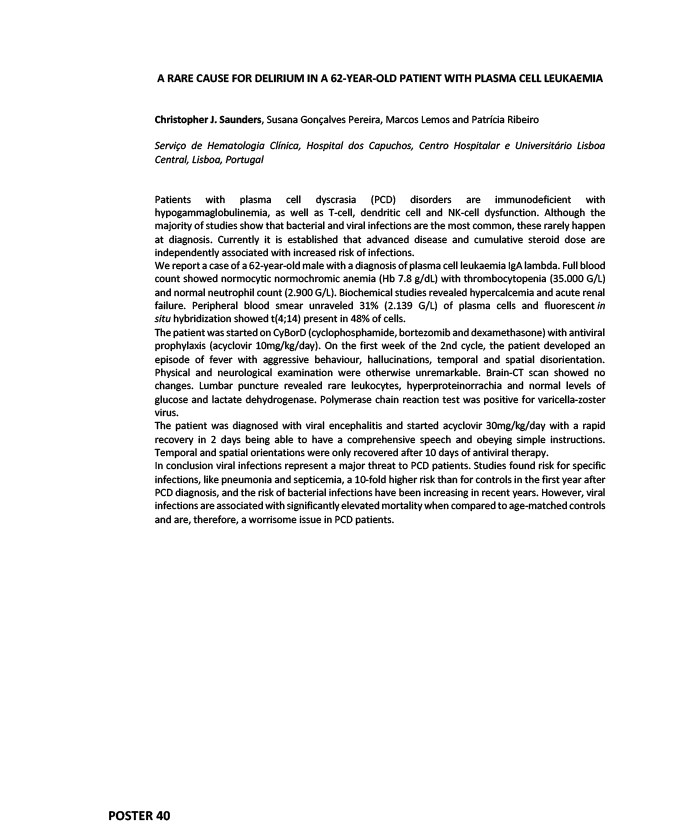
A RARE CAUSE FOR DELIRIUM IN A 62-YEAR-OLD PATIENT WITH PLASMA CELL LEUKAEMIA
Christopher J. Saunders, Susana Gonçalves Pereira, Marcos Lemos and Patrícia Ribeiro
Serviço de Hematologia Clínica, Hospital dos Capuchos, Centro Hospitalar e Universitário Lisboa
Central, Lisboa, Portugal
Patients with plasma cell dyscrasia (PCD) disorders are immunodeficient with
hypogammaglobulinemia, as well as T-cell, dendritic cell and NK-cell dysfunction. Although the
majority of studies show that bacterial and viral infections are the most common, these rarely happen
at diagnosis. Currently it is established that advanced disease and cumulative steroid dose are
independently associated with increased risk of infections.
We report a case of a 62-year-old male with a diagnosis of plasma cell leukaemia IgA lambda. Full blood
count showed normocytic normochromic anemia (Hb 7.8 g/dL) with thrombocytopenia (35.000 G/L)
and normal neutrophil count (2.900 G/L). Biochemical studies revealed hypercalcemia and acute renal
failure. Peripheral blood smear unraveled 31% (2.139 G/L) of plasma cells and fluorescent in
situ hybridization showed t(4;14) present in 48% of cells.
The patient was started on CyBorD (cyclophosphamide, bortezomib and dexamethasone) with antiviral
prophylaxis (acyclovir 10mg/kg/day). On the first week of the 2nd cycle, the patient developed an
episode of fever with aggressive behaviour, hallucinations, temporal and spatial disorientation.
Physical and neurological examination were otherwise unremarkable. Brain-CT scan showed no
changes. Lumbar puncture revealed rare leukocytes, hyperproteinorrachia and normal levels of
glucose and lactate dehydrogenase. Polymerase chain reaction test was positive for varicella-zoster
virus.
The patient was diagnosed with viral encephalitis and started acyclovir 30mg/kg/day with a rapid
recovery in 2 days being able to have a comprehensive speech and obeying simple instructions.
Temporal and spatial orientations were only recovered after 10 days of antiviral therapy.
In conclusion viral infections represent a major threat to PCD patients. Studies found risk for specific
infections, like pneumonia and septicemia, a 10-fold higher risk than for controls in the first year after
PCD diagnosis, and the risk of bacterial infections have been increasing in recent years. However, viral
infections are associated with significantly elevated mortality when compared to age-matched controls
and are, therefore, a worrisome issue in PCD patients.
POSTER 40